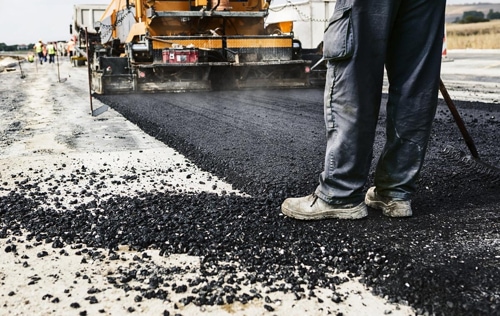If you want to get acquainted with asphalt, its features and the three most widely used types of asphalt in the world, stay tuned for the rest of this article.
What is asphalt made of?
Asphalt should be considered as one of the most important human inventions for the road development and transportation routes. Before the invention of asphalt, the roads were dirt and at best covered with stone. The use of paving stones to cover the surface of streets and roads is an old, very difficult method and of course have many drawbacks.
But today, for decades, asphalt has been accepted as the standard cover for streets and roads. Asphalts have greatly improved the speed of road development in the last half century by having very suitable features such as ease of execution, speed of execution, relatively low price, high durability and resistance to moisture.
In general, asphalt is made of sand, gravel and bitumen. The bitumen used in asphalt can be natural bitumen or Gilsonite or artificial bitumen or refinery bitumen. Natural bitumen is usually cheaper and gives asphalt special and useful properties. However, due to their low content, natural bitumen is usually used as a supplement to improve the properties of natural asphalt.
Types of asphalt
The grains used in asphalt, sand or any mixture of stone materials must have continuous granulation. Also, the use of modern machines and standard methods in the implementation of asphalt, especially in the infrastructure phase, is one of the most important factors in having a high quality and durable asphalt.
In a general classification, three types of hot, protective and cold asphalt can be identified.

Hot
This model is the most common type of asphalt used. This asphalt is obtained by combining sand grains and other rock materials with pure hot bitumen. To do this, the bitumen is heated to 105 to 163 degrees Celsius and after mixing with the grains, it is drawn in layers on the desired location. Finally, this material is compressed and flattened and can be used after cooling.
Hot asphalt itself has different types, which are divided according to the ratio of its ingredients. For example, concrete asphalt is a type of hot asphalt that uses fine stones in the composition of its grains.
This method is used to cover road surfaces, roofs and runways.
Cold
This type of asphalt is also made exactly like hot asphalt from sand, clay and bitumen. However, the bitumen used in this asphalt is emulsified and this feature helps it to be liquid at the room temperature. As a result, this asphalt model can be used without creating heat. However, in some types of cold asphalt, bitumen is heated to 90 C; But in this model, there is no need to heat the sand.
This asphalt is used in all pavements, especially on streets with light and medium traffic.
Protective
When the granular stones used in asphalt are very fine; This model of asphalt is called protective asphalt. Protective asphalts are used in thin layers (usually 2.5 cm) to protect surfaces such as isogum. This type of asphalt has a higher percentage of bitumen; And that’s why it’s not suitable for high-pressure surfaces such as roads.
Selection of the asphalt type
Choosing the asphalt type depends on many factors. But perhaps the most important factor is the type of soil and flooring in the area. Also, the type of surface use (road, street, alley, roof, etc.) and the amount of its application is another factor that helps experts in identifying the appropriate type of asphalt and combining it.


